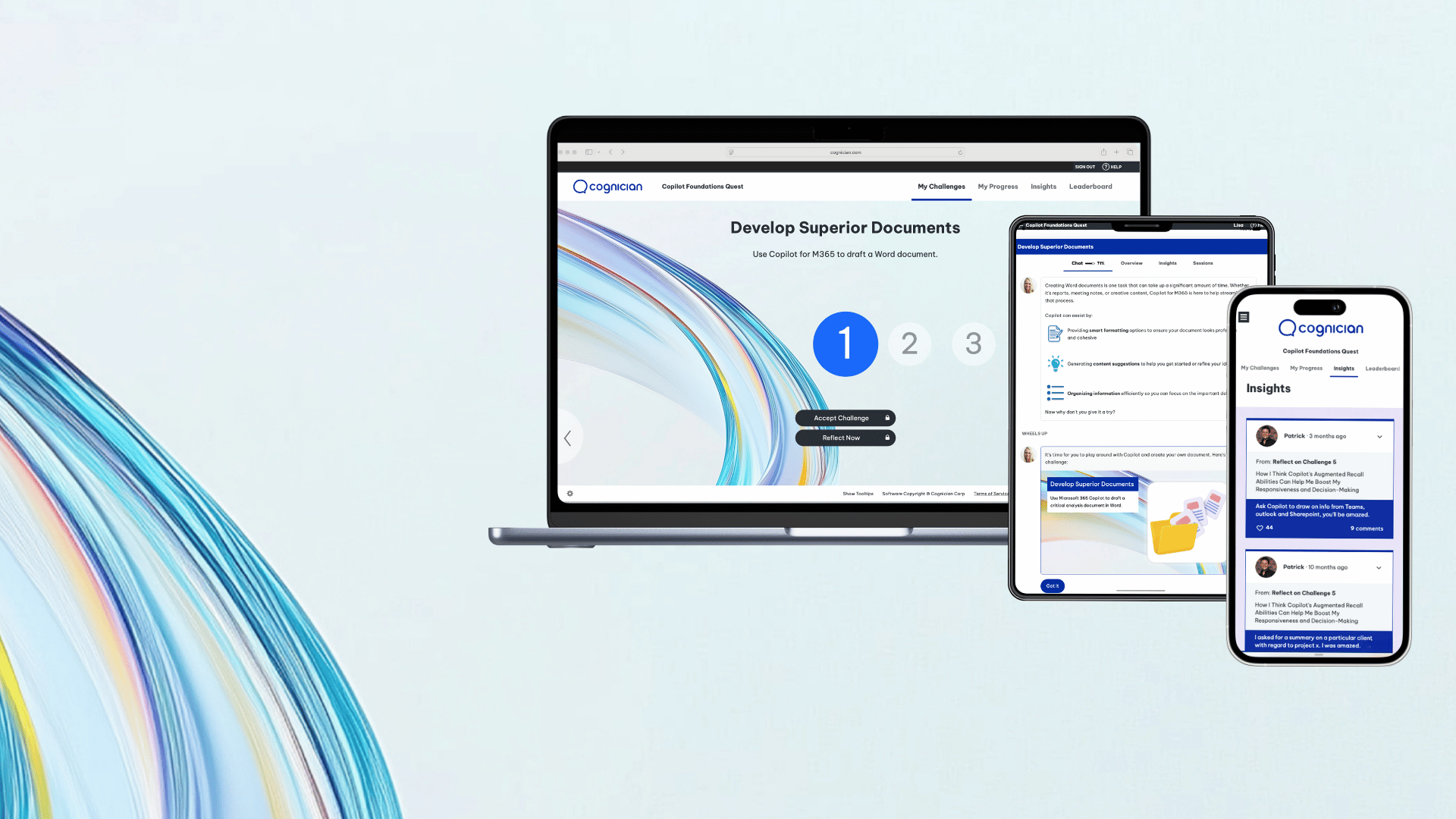Wondering how to leverage gamification? Here’s how we trigger powerful emotions and maximize engagement in our change programs.
From fitness trackers encouraging you to reach your step goal to collecting stamps for a free coffee, gamification is everywhere – and for a good reason. In this piece, we explore why points, badges, and rewards are key to creating successful learning programs. We'll also explore how we use gamification on our platform to enhance learner engagement and activate behavior change.
Defining Gamification
Just like games have all players start on the same level or board, let's all start at Level 1: defining what we mean when we use the term gamification. Simply put, gamification takes the fun, compelling, and interactive elements from games and applies them to everyday tasks, like learning.
To drill down a little deeper, it’s essential to define what a game is. We’ll borrow from game designer Jane McGonigal's four-point definition. A game, regardless of its type or structure, always has four key components:
- Goal: this is the specified outcome that a player works to achieve. It provides a sense of purpose. For instance, Mario’s goal is to make it through every castle to save Princess Peach from his nemesis, Bowser.
- Rules: this creates constraints and limitations, allowing a player to foster creative thinking and innovation. For example, there is a limit on the number of times a ball is allowed to bounce in tennis and boundaries for the court where the ball can be hit. These rules limit how and where shots can be played, requiring creativity to achieve success.
- Feedback System: this informs players how close they are to achieving their goal so as to motivate them. Players can see where they are with a progress bar, points, or levels. In addition, games provide feedback depending on a player's choices, from leveling up and acquiring new moves to their character dying.
- Voluntary Participation: players accept the rules, and this provides a common ground for a group of people to work together to achieve their goal. Defining the rules of engagement fosters a group connection where people learn, share, and solve problems collectively.
We build gamification elements into our programs because it taps into our innate human instincts, like competition, exploration, and curiosity. By triggering powerful emotions we can create positive user experiences and this, in turn, fosters engagement and makes learning stick.
Staying within the confines of Jane McGonigal's framework, we’ll show you how Cognician's work makes use of gamification with Quests in order to activate behavior change, and how you can incorporate this method into your existing change programs.
Goals
Our Quests are designed around unique material shared by subject matter experts, to activate desired behavioral habits. These habits become goals set for individual challenges or the overall program. Goals can be big or small. Think of how games have different types of objectives, some more complex than others, but all equipping you with necessary skills – because you can’t beat the 'boss' if you haven’t unlocked the right skills!
The mechanics of our Quests offer learners layered goals throughout a program. Just like the levels one has to complete to get to the very end of a video game , so our learners navigate through individual daily challenges, which vary in complexity and length, to get to the overarching goal of the program. Each day acts as a ‘level’ that learners must complete to continue their development.
This planned progression helps create a longer, more meaningful sense of purpose and achievement for the learner.
Rules
In a game, some areas may remain out of reach until unlocked or revealed as the player explores, and sometimes a player must complete specific actions to progress further. The Cognician platform is similar in that it is designed with learning constraints, or 'levels', in mind.
The learning pathway is revealed to the learner one day at a time and only moves in one direction. There is a subtle progression; the platform moves from left to right along a numbered pathway to create a sense of progression and natural forward momentum. A learner will encounter two buttons: 'challenge' and 'reflection'. The interface displays elegant minimalism, providing the learner with the things they need to focus on for their task.
Once the challenge is complete, the reflection is unlocked. These rules of engagement are repeated throughout and become intuitive, helping to channel the learner’s creativity, progressively disclosing one element at a time. This design allows users to focus on learning and the execution of goals for the program.
Feedback System
Feedback is crucial in any game: it allows a player to visually see their progress throughout the game and motivates them to continue. Therefore, our Quests have inbuilt mechanisms that help a learner understand their progress.
A Quest’s feedback loop can be immediate as can be seen in our chat space. The learner engages with a programmed digital coach who responds to their inputs, and response button copy that predicts a conversational reply. This chat function creates a call-and-response exchange that feels like a casual conversation.
In the chat space, feedback is also personalized. Content in a Quest can adapt dynamically based on how a user responds to prompts. Different choices lead to unique learning pathways and the unlocking of path-specific content.
Our system feedback also provides benchmarks for learners, including mindset maps and change charts that help a learner visually see their progress.
In addition, we also award learners with badges as they progress through their Quest. Badges can be awarded for a great start, a streak of completions, reaching the midpoint or last leg of a program, or even completing all of the modules – to name a few. And to further drive user engagement, we also make use of a leaderboard system that helps to drive healthy competition.
These multifaceted feedback systems motivate the learners, showing them that they're making progress and getting closer to achieving their goal with each action they perform.
Voluntary Participation
Games thrive when people want to play them and work together towards a common goal. It creates a sense of voluntary participation. Our Quests hold several ways for learners to engage with the platform and others on the program while making personalized choices. Two of the main ways we forge connections between users in a Quest is through reflection and insights.
Reflection
Once a user has completed a challenge, they are prompted to set a time for when they would like to come back and reflect on their challenge – this is intentional. People learn more from reflecting on their experiences than they do from their experiences alone.
This reflection mechanism also invites learners to participate freely, sharing as little or as much as they would like. Their contributions can lead to wider conversations among peers, further reflections, and opportunities to learn. Such mechanisms give the learner greater autonomy while simultaneously creating a wider sense of community.
Insights
Quests also contain insight opportunities: prompts that allow learners to comment on reflections and share thoughts, ideas, and personal experiences with others who are participating. They can opt to share this broadly or keep it private so that only they will see their post. 'Liking' and commenting on others’ shared insights adds a social layer to learning, with peer-learning driving group cohesion.
Final Thoughts
While there are numerous ways to engage a topic like gamification, here at Cognician we've attempted a more holistic, rewarding approach that focuses on creating powerful experiences which, in turn, drive lasting and sustainable behavior change. After all, as McGonigal says, "gameplay isn't just a pastime. It's a 21st century way of working together to accomplish real change".
By designing a platform that uses goals, rules, a feedback system, and voluntary participation, we create more than a momentary reward; we help to stimulate long-lasting change.



.png)

